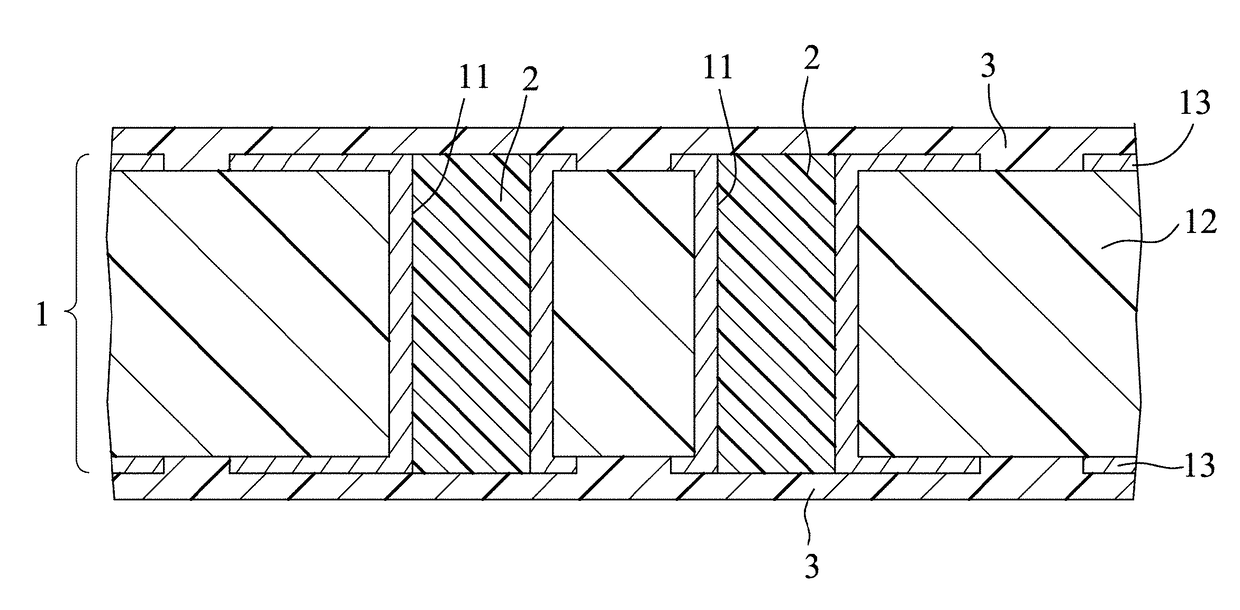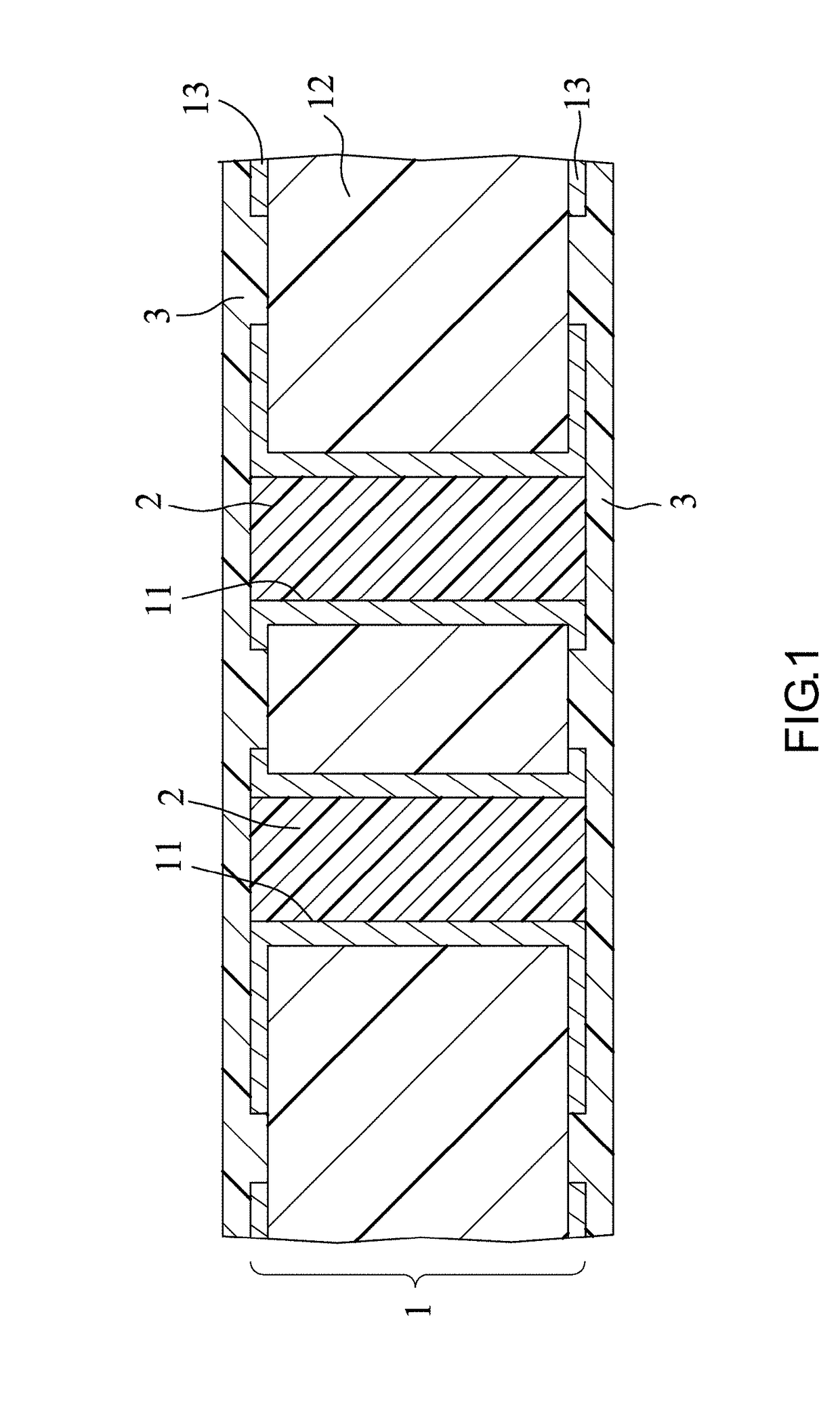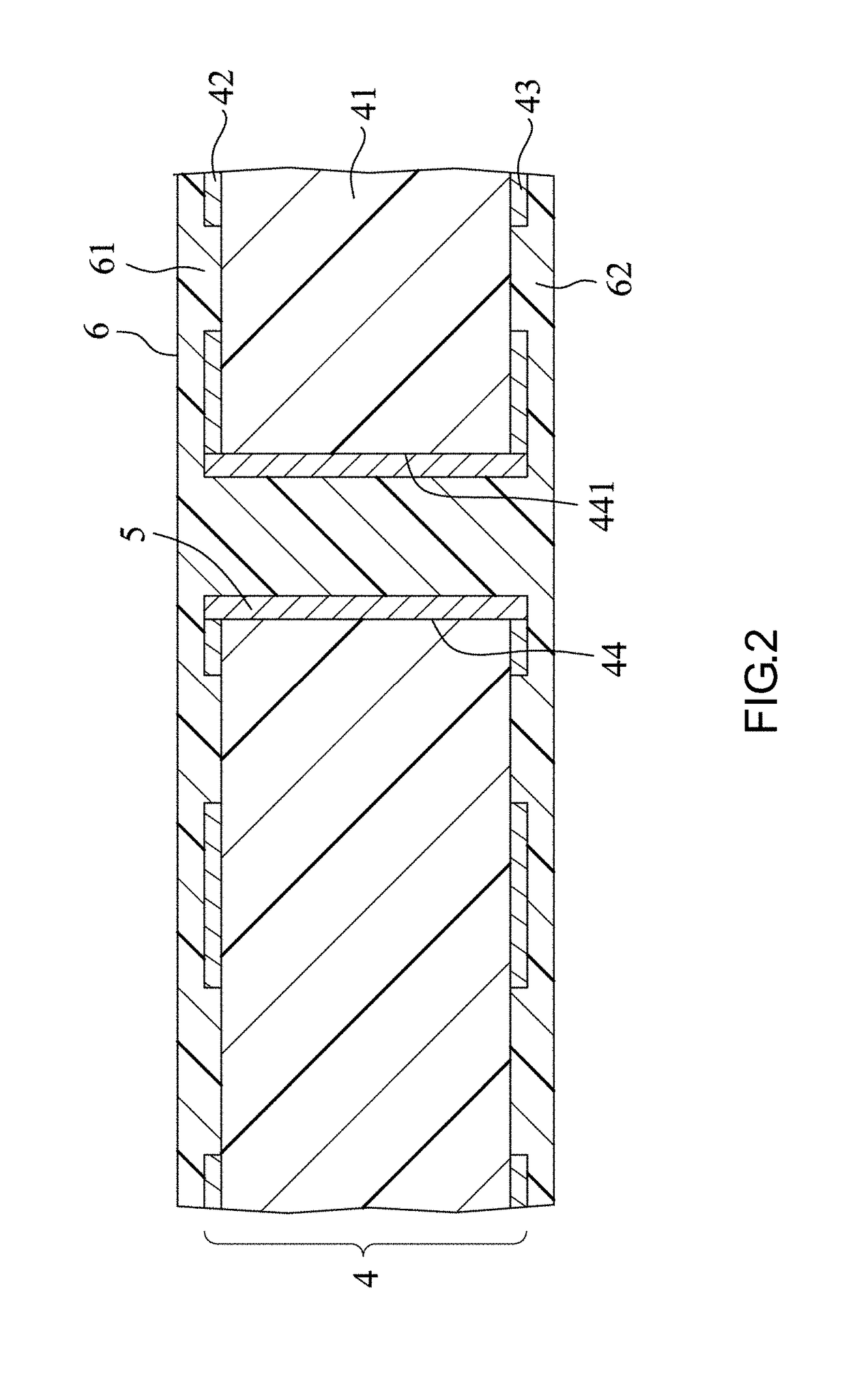Photosensitive and via-forming circuit board
a technology of printed circuit boards and viaforming, which is applied in the field of circuit boards, can solve the problems of poor heat resistance and flexibility of printed circuit boards, and cannot meet the needs of the industry, and achieve the effect of enhancing heat resistance and flexibility of circuit boards
- Summary
- Abstract
- Description
- Claims
- Application Information
AI Technical Summary
Benefits of technology
Problems solved by technology
Method used
Image
Examples
synthesis example 1
[0043]16.95 g (0.111 mol) of 3,5-diaminobenzoic acid, 13.07 g (0.032 mol) of 2,2-bis[4-(4-aminophenoxy)phenyl]propane, 75.60 g (0.080 mol) of bisaminopropyltetramethyldisiloxane, and 126.72 g of N-methyl-2-pyrrolidone were mixed to form a homogeneous mixture. 46.61 g (0.188 mol) of bicyclo[2,2,2]oct-7-ene-2,3,5,6-tetracarboxylic dianhydride was added to the homogeneous mixture, which was then mixed for 2 hours. Afterwards, 14.85 g (0.033 mol) of 4,4′-(hexafluoroisopropylidene)diphthalic anhydride was added and mixed for 4 hours at room temperature. After that, 65 g of xylene was added and then heated to the temperature for the polymerization reaction and mixed for 3 to 6 hours. After the temperature was down to 80° C., 7.92 g (0.056 mol) of glycidyl (meth)acrylate was added and then mixed between 80° C. to 120° C. for 12 hours. Next, the temperature was down to 25° C. and 301.72 g of the constituent containing the photosensitive polyimide was obtained. The solid content of the const...
synthesis example 2
[0044]16.45 g (0.108 mol) of 3,5-diaminobenzoic acid, 6.77 g (0.032 mol) of 1,3-bis(4′-aminophenoxy)benzene, 80.70 g (0.085 mol) of bisaminopropyltetramethyldisiloxane, and 168.14 g of N-methyl-2-pyrrolidone were mixed to form a homogeneous mixture. 46.93 g (0.178 mol) of 5-(2,5-dioxotetrahydro-3-furanyl)-3-methyl-3-cyclohexene-1,2-dicarboxylic anhydride was added to the homogeneous mixture, which was then mixed for 2 hours. Afterwards, 16.46 g (0.037 mol) of 4,4′-(hexafluoroisopropylidene)diphthalic anhydride was added and mixed for 4 hours at room temperature. After that, 65 g of xylene was added and then heated to the temperature for the polymerization reaction and mixed for 3 to 6 hours. After the temperature was down to 80° C., 7.68 g (0.054 mol) of glycidyl (meth)acrylate was added and then mixed between 80° C. to 120° C. for 12 hours. Next, the temperature was down to 25° C. and 343.13 g of the constituent containing the photosensitive polyimide was obtained. The solid conten...
synthesis example 3
[0045]18.62 g (0.122 mol) of 3,5-diaminobenzoic acid, 17.94 g (0.044 mol) of 2,2-bis[4-(4-aminophenoxy)phenyl]propane, 74.73 g (0.079 mol) of bisaminopropyltetramethyldisiloxane, and 231.98 g of N-methyl-2-pyrrolidone were mixed to form a homogeneous mixture. 41.82 g (0.213 mol) of cyclobutane-1,2,3,4-tetracarboxylic dianhydride was added to the homogeneous mixture, which was then mixed for 2 hours. Afterwards, 13.20 g (0.030 mol) of 4,4′-(hexafluoroisopropylidene)diphthalic anhydride was added and mixed for 4 hours at room temperature. After that, 65 g of xylene was added and then heated to the temperature for the polymerization reaction and mixed for 3 to 6 hours. After the temperature was down to 80° C., 8.70 g (0.061 mol) of glycidyl (meth)acrylate was added and then mixed between 80° C. to 120° C. for 12 hours. Next, the temperature was down to 25° C. and 406.99 g of the constituent containing the photosensitive polyimide was obtained. The solid content of the constituent conta...
PUM
| Property | Measurement | Unit |
|---|---|---|
| Diameter | aaaaa | aaaaa |
| Diameter | aaaaa | aaaaa |
| Flexibility | aaaaa | aaaaa |
Abstract
Description
Claims
Application Information
 Login to View More
Login to View More - R&D
- Intellectual Property
- Life Sciences
- Materials
- Tech Scout
- Unparalleled Data Quality
- Higher Quality Content
- 60% Fewer Hallucinations
Browse by: Latest US Patents, China's latest patents, Technical Efficacy Thesaurus, Application Domain, Technology Topic, Popular Technical Reports.
© 2025 PatSnap. All rights reserved.Legal|Privacy policy|Modern Slavery Act Transparency Statement|Sitemap|About US| Contact US: help@patsnap.com



